Brands across numerous industry segments mainly skincare, FMCG and F&B like gourmet coffees, packaged frozen foods, lifestyle and consumer tech, luxe health and wellness are attempting D2C and are successful at it. Although these product ranges are mid-high priced, they are successfully capturing consumers from Tier II and Tier III cities through D2C. Instagram ads of D2C online shopping websites, and listing products directly on social commerce platforms like Shopify are attracting huge traffic and purchases for small brands.
Benefits of going D2C and its need
Going D2C during the current pandemic is beneficial because people are confined to their living spaces and the most popular activity during lockdowns is to order for products online. Businesses across various industries can experience improved bottom lines by taking the D2C route. Digital infrastructure has given rise to the trend of quick one-tap buying of products online since customers need to fulfil their cravings and desire to get their favourite products home delivered during lockdowns.
Manufacturers now taking the direct selling route
Brands and manufacturers see D2C as an easy channel to sell products on a global scale. The first step to taking the direct selling route is to become a digital first brand. Consumer behaviour has taken a paradigm shift in the recent past. Social distancing has forced people to purchase a range of goods through online channels. Digital mediums are heavily influencing the decision-making process of online shoppers. Manufacturers and brands thus began taking the direct selling route to meet the high demand. There has also been a shift in consumption demographics with more demand coming from women shoppers belonging to Tier II and III cities. Traditional retailers and manufacturers are thus jumping in to take a piece of the cake.
‘‘
Businesses across various industries can experience improved bottom lines by taking the D2C route
5 Things to Consider when going D2C
Why Customers should buy from you directly
While going to D2C, you need to rebuild your brand by investing in community building, new products, and technology. You need to build trust with your consumers and offer them a deep connection with your brand. Strategic brand investments build a strong position for customers to buy from you directly. To encourage customers, you need to have an e-commerce strategy which does not only involve creating a website.
Online Infrastructure
Online infrastructure needed for D2C includes an Operating System which will be a combination of product, technology, and e-commerce expertise. You need to have strong sourcing, design, digital marketing, and inventory management capabilities.
Investing in Traffic
You need to consider whether you can invest in traffic for customers to directly shop from you. Unlike a few years ago, brands invested in television ads to market their products and create traffic. Now this practice is not necessary. However, there are already marketplaces with large distribution networks like Amazon, Flipkart, and Nykaa. If you’d rather create your own technology to replace the need for relying on them, you need to consider whether you have enough investment for the same.
Data
When it comes to order fulfilment, D2C brands have the responsibility of data management, stocks, inventory, and forecasting. Since order fulfilment completely falls on your shoulders, you need to navigate challenges of stockpiling and catalogue management. You also need to have technology that can make accurate order forecasts, based on which you need to make appropriate production planning.
Security
When you operate your own D2C selling channel through a website, app, etc., security becomes an important area of concern. Cyber attacks are rampant on small e-commerce firms, and data breaches have become commonplace. New websites suffer from endless brute force attacks. You need to consider whether you have the bandwidth to incorporate a dedicated cyber security team and capital for data security technology. While setting up a payment gateway, you will no doubt be dealing with storage of customer payment information. Security is thus a critical factor to consider.




